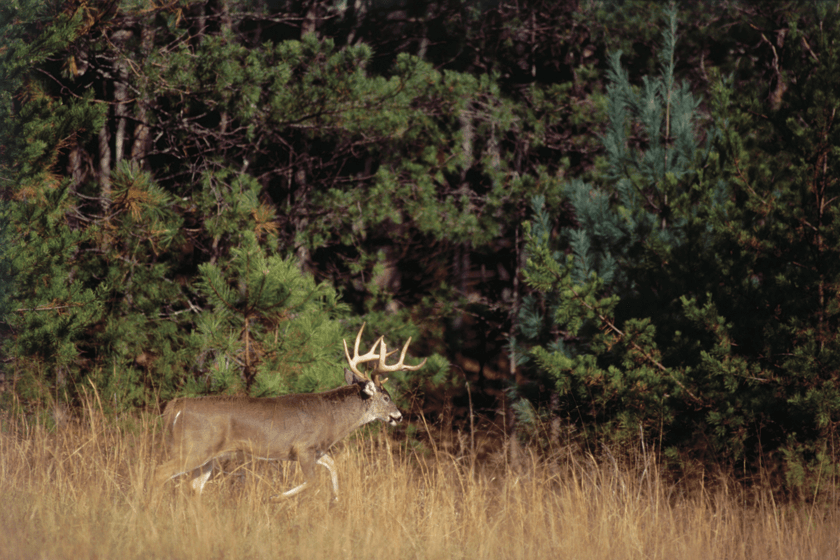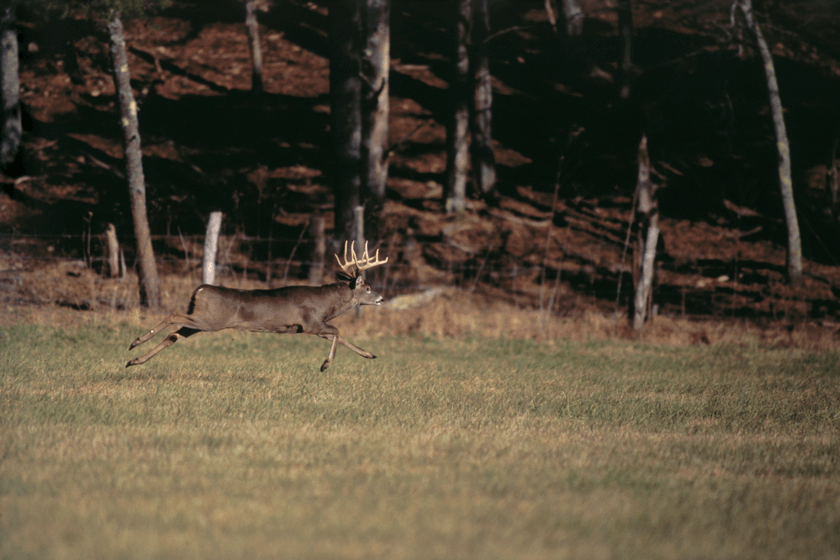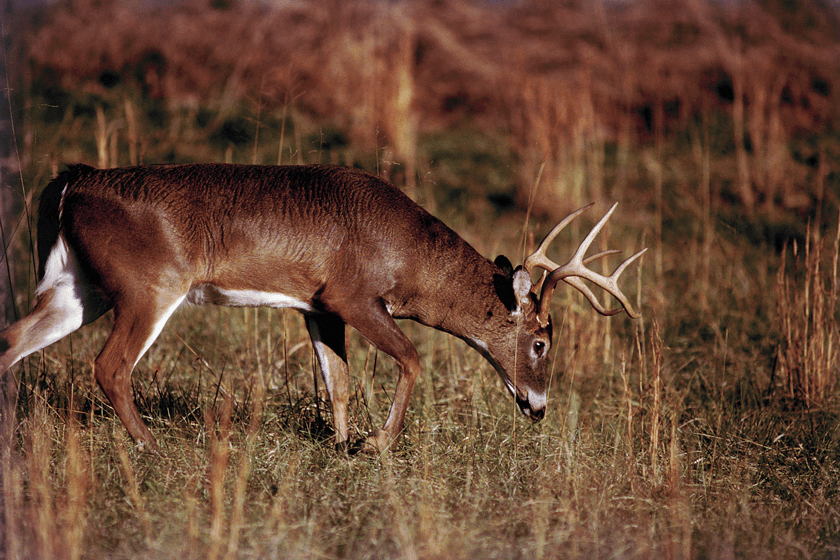
Although your adrenaline is at its peak in the moments after you shoot, do your best to pay attention to the reaction of the deer. Doing so could confirm a hit or a miss, help you estimate where the arrow made contact, and aid you in its recovery.
As the buck approached, I gazed ahead and spotted the shooting lane. He would be there in seconds, and I knew the day of truth had arrived. A cluster of honeysuckle allowed me to draw my bow. Then, he entered the small opening I had made several weeks earlier after setting up the stand.
Upon releasing the arrow, I saw the white vanes disappear into the deer, forward and slightly low. Meanwhile, the buck’s hind legs kicked out. He ran hard for 30 yards, then slowed to a staggering walk like someone well over their legal limit of alcohol. His tail twitched erratically as he did his best to stay on his feet, but I could see that time was against him. Moments later, he fell and lay motionless.
Although the kill was quick and took only seconds, I had already determined the arrow zipped through the buck’s heart. A visual confirmation gave me a good idea of where the arrow hit, but it was the deer’s reaction to the impact that provided solid evidence of a heart shot.
Most archers take only ethical shots and have a good understanding of whitetail anatomy.
Bowhunters shoot for the largest vital area — the lungs. Nevertheless, it takes only an inch of aiming error to turn a quick recovery into a long tracking endeavor. This is especially true of deer that travel long distances because of bowhunters who begin tracking too soon after the shot. This most often happens because the archer has failed to accurately understand where the arrow hit and assumes he will have a prompt recovery.
The Boiler Room
I’ve always classified the vital heart and lungs as the boiler room. An arrow that takes out both lungs will result in a quick and humane kill. The lungs of an adult deer are roughly nine inches in diameter and offer the largest target.

A deer that is hit in both lungs typically runs hard and fast. This is provided the heart is spared. They remind me of a racehorse running down the final stretch of the track. Long strides are common, and their belly is low to the ground.
Most deer that are hit will flee the scene with their tail down. Watch deer carefully after the shot for any clues you can gather about where they are hit. Such clues can be extremely helpful in planning your recovery strategy.
While this is the common reaction, exceptions do exist. Consider a mature doe my son shot several years ago as it stood broadside. He swore the arrow passed through the deer just behind the shoulder but began to wonder after she ran a short distance, stopped, looked back and snorted. Then she fell to the ground. Upon field dressing the deer, it was obvious the arrow had penetrated both lungs. I point this out just to let you know unusual incidents do occur.
The lung-shot deer usually runs only 100-150 yards. However, if the broadhead takes out only one lung, their reaction could be entirely different. Many run hard at first but slow to a walk after a short distance. A deer shot in only one lung is often difficult to recover and requires extreme patience when tracking.
The buck mentioned at the beginning of this story reacted like a classic heart-shot deer.
Back legs usually kick out as the deer promptly leaves the scene, appearing as if they received an electrical shock. They run erratically for a brief distance and may change directions repeatedly. It’s common for them to slow down just before they drop.
There are cases where heart-shot deer have traveled up to 200 yards, but this usually occurs if the arrow only nicks or slices the heart. An arrow that hits low, just behind the front leg at the brisket, could nick the heart and miss the lungs entirely.
A paunch-shot deer will typically walk very slowly, with its head down. Another common trait of the paunch-shot deer is a hunched over appearance. As the deer walks, its back end could appear raised, with the legs in a wide stance.
The Abdominal Wound
The reaction of a deer hit in the abdomen differs greatly from that of a lung- or heart-shot deer. In fact, the difference is like night and day.
Tracking the animal also requires a different approach.
I classify an abdomen shot as anything including liver, stomach and intestines. Although the kidneys are located high and just in front of the hips, they do not relate to the paunch wound. A severed kidney results in immediate hemorrhage and will put a deer down quickly.
A paunch-shot deer usually runs only a short distance before stopping. In many instances, it will jump or flinch as the arrow hits before bounding away. It seldom runs hard and will usually appear to lope. The distance it travels before stopping could vary from only a few yards to 100 yards. In many cases, a deer with an abdomen wound will stop within 50 yards.
Once the deer stops, it could stand in place for one or more minutes. I know of one liver-shot buck that ran about 80 yards before stopping. It then stood in one location for 15 minutes before slowly walking away.
Once a paunch-shot deer begins walking, it will move very slowly with its head down.
Another common trait of the paunch-shot deer is a hunched over appearance. As the deer walks, its back end could appear raised, with the legs in a wide stance.
Most deer with an abdominal wound will bed down within a short distance if left alone.
If you can’t find blood on the ground after the shot, your next best option is to find your arrow and examine it carefully. Bright-colored blood on your shaft could indicate a lung hit, while darker blood or stomach material are sure signs of an abdomen shot. And, of course, if the arrow is free of blood and/or hair, you know it was a clean miss.
The liver-shot buck mentioned previously laid down after walking 40 yards from where it had stood. I was able to see this from my stand only because I had excellent visibility.
The bedding down quick theory is applicable with a liver or stomach wound — but only if the hunter does not begin tracking too quickly. The exception is the intestinal-shot deer, which could travel much further before bedding.
I suggest waiting several hours before tracking an abdomen-shot deer. This deer can be recovered if the hunter is patient.
Muscular and Skeletal Reactions
One common muscular and skeletal wound is the back shot. A friend of mine refers to this as “no man’s land.” That’s understandable, since a deer hit here is difficult to recover. Although there is a major artery that runs perpendicular with the back, most high hits will miss this vital blood vessel. Of course, a high hit could result in a spine shot that drops a deer immediately, but it should not be considered a target. Back hits usually occur when the archer does not get down on his target, or misjudges yardage.

Most deer hit high will run hard and fast, resembling that of a lung-shot deer. There are a couple of differences, however. A deer with a back wound runs hard but doesn’t take the long strides. Thus, the belly will not appear low to the ground. Most back-shot deer will usually stop running within 100 yards, whereas the lung-shot deer will usually run hard until it goes down. Determining the difference, though, could depend upon your visibility.
Other muscular and skeletal wounds will react in much the same way as the back-shot deer. One exception is the hip shot. Even when bone is missed, an arrow will inflict major damage to the ham muscle. You often notice this when the deer exits, since it could favor one leg. You might find more evidence when you track the deer, since blood typically runs down the leg and is found in tracks.
Fortunately, many muscular and skeletal wounds are superficial.
A deer that flees the scene of a shot with its tail flagging may indicate a clean miss. Deer that are missed also will often stop after a short distance and look back curiously at the site where the arrow sailed past them.
Nevertheless, I suggest you always give 100 percent when tracking such an animal. As mentioned previously, there are always exceptions to how a deer reacts when hit, and you seldom know exactly where your arrow hit until you make a recovery.
The Clean Miss
Like most bowhunters, I’ve missed my share of deer. It’s easy to do and will often occur from no fault of our own. There are always those dreadful limbs that seem to come out of nowhere. Then there are times when that dreaded buck fever interferes with our concentration.
Nevertheless, we cannot always determine if we hit or miss when the shot is taken. I can’t tell you how many times I’ve sat in my stand wondering if I missed or hit the deer.
Sometimes I’ve been sure of a hit, only to discover a complete and embarrassing miss.
Other times, I’ve cursed myself for missing, only to discover a perfect hit. Usually, when I’ve mistaken a hit or miss, it’s due to poor visibility following the shot.
It’s normal for deer to run when a miss occurs. However, there are telltale signs that seem to point to a probable miss. Consider the deer’s alertness. If he runs and stops, looks back with the head held high, there’s a good chance you missed. Most deer, when hit, do not want to stick around and ask questions. A wounded deer seldom runs and then stops to look back and focus on the shot location. Of course, it’s common for a deer to appear spooked when missed, even if it has no idea what happened. Some will not demonstrate curiosity, while others will.
Another trait of a hit deer is the tail dropping. The tail of some deer will drop halfway the first few yards it runs, and then drop completely after running further. Most deer you miss will run with their tail flagging. Again, consider this only a general rule. I’ve seen a few mortally wounded deer run with their tail flagging until they fell or stopped running.
Sounds that follow the shot could indicate a hit or miss. When an arrow hits the body cavity, you usually hear a dull thump. A loud crack could indicate bone, such as a rib, but it also could be the sound of the arrow hitting a tree or rock. Such was the case for me last season when a 10-pointer came into my grunts. I shot between two small hickory trees and thought I was on target. I heard the loud noise of the arrow hitting, well, something. The buck lunged forward, ran a short distance, stopped and looked back. I searched for 30 minutes for my arrow, to no avail. Only when my wife Vikki showed up and helped did I unravel the mystery. She spotted my arrow 10 feet above the ground, dead center in one of the hickories.
There is one final note worth mentioning about a hit or miss. Most archers know when they make a good shot as soon as they release. If you shoot within your effective range, have no doubts as to yardage and are not trying to push an arrow through a tight opening, you can be almost certain you will get the job done. The only other thing is to know that you aimed and followed through. I’m usually aware of this and can be certain that when I release the arrow the job will be done. Then there are those times that I did not do as I should have — I knew when I released that I could be in trouble!









































![Air gun 101: The differences between .177 & .22 – Which jobs they do best ? [Infographic]](https://airgunmaniac.b-cdn.net/wp-content/uploads/2024/11/1773-150x150.jpeg)

